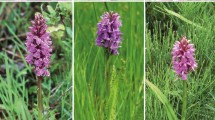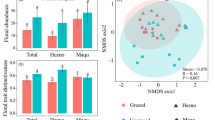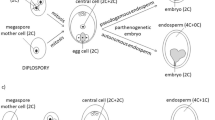Abstract
A predominant theme in the study of orchid evolution has been the importance of floral traits contributing to pollinator-mediated isolating barriers (i.e., floral isolation). However, few studies have quantified the contribution of floral isolation in sympatric orchid populations. Cypripedium parviflorum vars. makasin and pubescens are excellent taxa to test the strength of floral isolation because of their recent phylogenetic separation, overlapping flowering phenologies, and sympatric populations that can lack intermediate morphologies. In this paper, we use sympatric populations to (1) test for pre-mating and early-acting post-mating reproductive isolating barriers, (2) quantify genetic differentiation among populations using allozyme loci, and (3) document floral size differences between varieties. Pollen tracking experiments using fluorescent powders revealed minimal inter-varietal pollen movement. Across two sympatric sites, only 4 inter-varietal pollinations were observed among 52 var. makasin pollinations and 40 var. pubescens pollinations. All of these inter-varietal pollinations had var. makasin as the pollen donor. In contrast, artificial crosses within and between the varieties revealed no statistically significant differences in fruit set, seed weight, or embryo morphology. Allozyme data are consistent with restricted inter-varietal gene flow, showing strong allele frequency differences between the varieties across multiple loci. In a clustering analysis, these differences caused the varieties to group taxonomically and not by their geographic location. These data along with statistically significant morphological differences between the varieties strongly suggest the existence of a pollinator-mediated isolating barrier. The possible nature of the isolating barrier is discussed as well as the likelihood of other late acting post-zygotic barriers.


Similar content being viewed by others
References
Aldridge G, Campbell DR (2007) Variation in pollinator preference between two Ipomopsis contact sites that differ in hybridization rate. Evolution 61:99–110
Argue CL (2012) The pollination biology of North American orchids: volume 1. Springer, New York, pp 19–23
Arnold ML (2000) Anderson’s paradigm: Louisiana irises and the study of evolutionary phenomena. Mol Ecol 9:1687–1698
Atwood JT Jr (1985) The Cypripedium calceolus L. complex in North America. In: Tan KW (ed) Proceedings of the eleventh world orchid conference. International Press Co, Singapore, pp 106–110
Ayasse M, Schiestl FP, Paulus HF, Löfstedt C, Hansson B, Ibarra F, Francke W (2000) Evolution of reproductive strategies in the sexually deceptive orchid Ophrys Sphegodes: How does flower-specific variation of odor signals influence reproductive success? Evolution 54:1995–2006
Bänziger H, Sun H, Luo YB (2005) Pollination of a slippery lady slipper orchid in south-west China: Cypripedium guttatum (Orchidaceae). Bot J Linn Soc 148:251–264
Bänziger H, Sun H, Luo YB (2008) Pollination of wild lady slipper orchids Cypripedium yunnanense and C. flavum (Orchidaceae) in south-west China: why are there no hybrids? Bot J Linn Soc 156:51–64
Barkman TJ, Beaman JH, Gage DA (1997) Floral fragrance variation in Cypripedium: implications for evolutionary and ecological studies. Phytochemistry 44:875–882
Barrett CF, Freudenstein JV, Taylor DL, Kõjalg U (2010) Rangewide analysis of fungal associations in the fully mycoheterotrophic Corallorhiza striata complex (Orchidaceae) reveals extreme specificity on ectomycorrhizal Tomentella (Thelephoraceae) across North America. Am J Bot 97:628–643
Barrows EM (1983) Cypripedium flowers entrap adult Thymelicus (Lepidoptera: Hesperiidae) in Northern Michigan. J Lepid Soc 37:265–268
Bellusci F, Pellegrino G, Palermo AM, Musacchio A (2010) Crossing barriers between the unrewarding Mediterranean orchids Serapias vomeracea and Serapias cordigera. Plant Species Biol 25:68–76
Bergström G, Birgersson G, Groth I, Nilsson LA (1992) Floral fragrance disparity between three taxa of lady’s slipper Cypripedium calceolus (Orchidaceae). Phytochemistry 31:2315–2319
Bernhardt P, Edens-Meier R (2010) What we think we know vs. what we need to know about orchid pollination and conservation: Cypripedium L. as a model lineage. Bot Rev 76:204–219
Case FW (1987) Orchids of the western great lakes region. Cranbrook Institute of Science Bulletin 48, Bloomfield Hills MI, pp 75–79
Case MA, Bradford ZR (2009) Enhancing the trap of lady’s slippers: a new technique for discovering pollinators yields new data from Cypripedium parviflorum (Orchidaceae). Bot J Linn Soc 160:1–10
Cockerell TDA (1915) Notes on orchids. Bot Gaz 59:331–333
Correll DS (1938) Cypripedium calceolus var. pubescens. Bot Mus Leafl, Harv Univ 7:1–18
Cozzolino S, Scopece G (2008) Specificity in pollination and consequences for post-mating reproductive isolation in deceptive Mediterranean orchids. Phil Trans R Soc B 363:3037–3046
Cozzolino S, Widmer A (2005a) The evolutionary basis of reproductive isolation in Mediterranean orchids. Taxon 54:977–985
Cozzolino S, Widmer A (2005b) Orchid diversity: an evolutionary consequence of deception? Trends Ecol Evol 20:487–494
Cozzolino S, Widmer A (2006) Response to Otero and Flanagan: Orchid diversity—beyond deception. Trends Ecol Evol 21:65–66
Cozzolino S, Schiestl FP, Müller A, De Castro O, Nardella AM, Widmer A (2005) Evidence for pollinator sharing in Mediterranean nectar-mimic orchids: absence of pre-mating barriers? Proc R Soc Lond Ser B Biol Sci 272:1271–1278
Cribb P (1997) The genus Cypripedium. Timber Press, Portland
Darwin C (1862) On the various contrivances by which British and foreign orchids are fertilised by insects, and on the good effects of intercrossing. John Murray, London
Devey DS, Bateman RM, Fay MF, Hawkins JA (2009) Genetic structure and systematic relationships within the Ophrys fuciflora aggregate (Orchidaceae: Orchidinae): high diversity in Kent and a wind-induced discontinuity bisecting the Adriatic. Ann Bot 104:483–495
Ellis AG, Johnson SD (1999) Do pollinators determine hybridization patterns in sympatric Satyrium (Orchidaceae) species? Plant Syst Evol 219:137–150
Erneberg M, Holm B (1999) Bee size and pollen transfer in Cypripedium calceolus (Orchidaceae). Nord J Bot 19:363–367
Ewacha B, Sheviak CJ (2004) Cypripedium x herae, a natural Cypripedium hybrid from central Canada. Orchids 73:296–299
Fay MF, Chase MW (2009) Orchid biology: from Linnaeus via Darwin to the 21st century. Ann Bot 104:359–364
Gögler J, Stökl J, Sramkova A, Twele R, Francke W, Cozzolino S, Cortis P, Scrugli A, Ayasse M (2009) Ménage à trios—two endemic species of deceptive orchids and one pollinator species. Evolution 63:2222–2234
Grant V (1949) Pollination systems as isolating mechanisms in Angiosperms. Evolution 3:82–97
Guignard JA (1886) Insects and orchids. Sixth Ann Rep Entomol Soc Ont 16:39–48
Guo SW, Thompson EA (1992) Performing the exact test of Hardy–Weinberg proportion for multiple alleles. Biometrics 48:361–372
Haldane JBS (1954) An exact test for randomness of mating. J Genet 52:631–635
Hedrick PW (2011) Genetics of populations. Jones and Bartlett, Sudbury, pp 479–483
Herring T (2007) A study of the reproductive systems of selected North American and Chinese Cypripedium species (Orchidaceae). Saint Louis University, Dissertation
Hu S, Hu H, Yan N, Huang J, Li S (2011) Hybridization and asymmetric introgression between Cypripedium tibeticum and C. yunnanense in Shangrila County, Yunnan Province, China. Nord J Bot 29:625–631
Internicola AI, Juillet N, Smithson A, Gigord LDB (2006) Experimental investigation of the effect of spatial aggregation on reproductive success in a rewardless orchid. Oecologia 150:435–441
Jersáková J, Johnson SD, Kindlmann P (2006) Mechanisms and evolution of deceptive pollination in orchids. Biol Rev 81:219–235
Klier KM, Leoschke J, Wendel JF (1991) Hybridization and introgression in white and yellow ladyslipper orchids (Cypripedium candidum and C. pubescens). J Hered 82:305–318
Knyasev MS, Kulikov PV, Knyaseva OI, Semerikov VL (2000) Interspecific hybridization in northern Eurasian Cypripedium: morphometric and genetic evidence of the hybrid origin of C. ventricosum. Lindleyana 15:10–20
Li P, Luo YB, Bernhardt P, Yang XQ, Kou Y (2006) Deceptive pollination of the lady’s slipper Cypripedium tibeticum (Orchidaceae). Plant Syst Evol 262:53–63
Li P, Luo Y, Bernhardt P, Kou Y, Perner H (2008) Pollination of Cypripedium plectrochilum (Orchidaceae) by Lasioglossum spp. (Halictidae): the roles of generalist attractants versus restrictive floral architecture. Plant Biol 10:220–230
Micheneau C, Johnson SD, Fay MF (2009) Orchid pollination: from Darwin to the present day. Bot J Linn Soc 161:1–19
Moccia MD, Widmer A, Cozzolino S (2007) The strength of reproductive isolation in two hybridizing food-deceptive orchid species. Mol Ecol 16:2855–2866
Namsook L, Changshook L (2007) Molecular evidence for interspecific hybridization of the section Cypripedium of genus Cypripedium (Orchidaceae). Botany and plant biology joint congress abstract 1594, Chicago, Illinois
Neiland MRM, Wilcock CC (1998) Fruit set, nectar reward, and rarity in the Orchidaceae. Am J Bot 85:1657–1671
Newhouse CJ (1976) Pollination biology in seven taxa of Michigan Orchidaceae and a study of Cypripedium calceolus in Michigan based on living plants and herbarium specimens. Michigan State University, MS Thesis
Nilsson LA (1979) Anthecological studies on the Lady’s Slipper, Cypripedium calceolus (Orchidaceae). Bot Notiser 132:329–347
Nilsson LA (1992) Orchid pollination biology. Trends Ecol Evol 7:255–259
Nybom H (2004) Comparison of different nuclear DNA markers for estimating intraspecific genetic diversity in plants. Mol Ecol 13:1143–1155
Otero JT, Flanagan NS (2006) Orchid diversity—beyond deception. Trends Ecol Evol 21:64–65
Pellegrino G, D’Emerico S, Musacchio A, Scrugli A, Cozzolino S (2005) Confirmation of hybridization among sympatric insular populations of Orchis mascula and O. provincialis. Plant Syst Evol 251:131–142
Raymond M, Rousset F (1995) GENEPOP (version 1.2): population genetics software for exact tests and ecumenicism. J Heredity 86:248–249
Ren Z, Li D, Bernhardt P, Wang H (2011) Flowers of Cypripedium fargesii (Orchidaceae) fool flat-footed flies (Platypezidae) by faking fungus-infected foliage. PNAS 108:7478–7480
Robertson C (1924) Flowers and insects XXIII. Bot Gaz 78:68–84
Rogers JS (1972) Measures of genetic similarity and genetic distance. Stud Genet, Univ Tex Publ 7213:145–154
Rousset F (2008) Genepop’007: a complete re-implementation of the Genepop software for Windows and Linux. Mol Ecol Resour 8:103–106
Schatz B (2006) Fine scale distribution of pollinator explains the occurrence of the natural orchid hybrid × Orchis bergonii. Ecoscience 13:111–118
Schiestl FP (2005) On the success of a swindle: pollination by deception in orchids. Naturwissenschaften 92:255–264
Schiestl FP, Schlüter PM (2009) Floral isolation, specialized pollination, and pollinator behavior in orchids. Annu Rev Entomol 54:425–446
Scopece G, Musacchio A, Widmer A, Cozzolino S (2007) Patterns of reproductive isolation in Mediterranean deceptive orchids. Evolution 61:2623–2642
Scopece G, Widmer A, Cozzolino S (2008) Evolution of postzygotic reproductive isolation in a guild of deceptive orchids. Am Nat 171:315–326
Shefferson RP, Taylor DL, Weiss M, Garnica S, McCormick MK, Adams S, Gray HM, McFarland JW, Kull T, Tali K, Yukawa T, Kawahara T, Miyoshi K, Lee Y (2007) The evolutionary history of mycorrhizal specificity among lady’s slipper orchids. Evolution 61:1380–1390
Sheviak CJ (1992) Natural hybridization between Cypripedium montanum and its yellow lipped relatives. Am Orchid Soc Bull 61:546–559
Sheviak CJ (1994) Cypripedium parviflorum Salisb. 1: The small flowered varieties. Am Orchid Soc Bull 63:664–669
Sheviak CJ (1995) Cypripedium parviflorum Salisb. part 2: The larger-flowered plants and patterns of variation. Am Orchid Soc Bull 64:606–612
Sheviak CJ (2002) Cypripedium parviflorum. In: Flora of North America Editorial Committee (eds 1993+) Flora of North America North of Mexico, 16+ vols. New York and Oxford, vol 26. pp 504–507
Sheviak CJ (2010) Cypripedium parviflorum in the Northwest, with the description of a new variety. Nat Orchid Conf J 7:1–9
Shimura H, Sadamoto M, Matsuura M, Kawahara T, Naito S, Koda Y (2009) Characterization of mycorrhizal fungi isolated from the threatened Cypripedium macranthos in a northern island of Japan: two phylogenetically distinct fungi associated with the orchid. Mycorrhiza 19:525–534
Stökl J, Schlüter PM, Stuessy TF, Paulus HF, Assum G, Ayasse M (2008) Scent variation and hybridization cause the displacement of a sexually deceptive orchid species. Am J Bot 95:472–481
Stoutamire WP (1967) Flower biology of the lady’s slippers. Mich Botanist 6:159–175
Sugiura N, Fujie T, Inoue K, Kitamura K (2001) Flowering phenology, pollination, and fruit set of Cypripedium macranthos var. rebunense, a threatened Lady’s Slipper (Orchidaceae). J Plant Res 114:171–178
Tremblay RL (1992) Trends in the pollination ecology of the Orchidaceae: evolution and systematics. Can J Bot 70:642–650
Tremblay RL (1994) Frequency and consequences of multi-parental pollinations in a population of Cypripedium calceolus var. pubescens (Orchidaceae). Lindleyana 9:161–167
Tremblay RL, Ackerman JD, Zimmerman JK, Calvo RN (2005) Variation in sexual reproduction in orchids and its evolutionary consequences: a spasmodic journey to diversification. Biol J Linn Soc 84:1–54
Van der Niet TS, Johnson SD, Linder HP (2006) Macroevolutionary data suggest a role for reinforcement in pollination system shifts. Evolution 60:1596–1601
Van der Pijl L, Dodson CH (1966) Orchid flowers: their pollination and evolution. The Fairchild Tropical Garden and the University of Miami Press, Coral Gables Florida
Wallace LE (1997) Systematic and population genetic analyses of northern vs. southern yellow lady’s slippers (Cypripedium parviflorum vars. parviflorum, pubescens, and makasin): inference from isozyme and morphological data. The College of William and Mary, USA, MS thesis
Wallace LE, Case MA (2000) Contrasting allozyme diversity between northern and southern populations of Cypripedium parviflorum (Orchidaceae): implications for Pleistocene refugia and taxonomic boundaries. Syst Bot 25:281–296
Weir BS (1996) Genetic Data Analysis II. Sinauer, Sunderland
Weir BS, Cockerham CC (1984) Estimating F-statistics for the analysis of population structure. Evolution 38:1358–1370
Worley AC, Sawich L, Ghazvini H, Ford BA (2009) Hybridization and introgression between a rare and a common lady’s slipper orchid, Cypripedium candidum and C. parviflorum (Orchidaceae). Botany 87:1054–1065
Xu S, Schlüter PM, Scopece G, Breitkopf H, Gross K, Cozzolino S, Schiestl FP (2011) Floral isolation is the main reproductive barrier among closely related sexually deceptive orchids. Evolution 65:2606–2620
Acknowledgments
We thank L. E. Wallace for assisting with the electrophoretic work while at William and Mary as well as contributing to many stimulating conversations about lady’s slippers. Beth Everett assisted with collecting the viability data and we are grateful for her care and patience. Charles Sheviak and an anonymous reviewer provided critical comments on a previous version of this manuscript and we thank them for helping to improve the quality of this publication. Project funding was provided by a faculty research grant from the College of William and Mary.
Author information
Authors and Affiliations
Corresponding author
Rights and permissions
About this article
Cite this article
Case, M.A., Bierbaum, T.J. Pollinator-mediated mating restriction between sympatric varieties of yellow lady’s slipper orchids (Cypripedium parviflorum Salisb.). Plant Syst Evol 299, 1721–1735 (2013). https://doi.org/10.1007/s00606-013-0828-4
Received:
Accepted:
Published:
Issue Date:
DOI: https://doi.org/10.1007/s00606-013-0828-4




